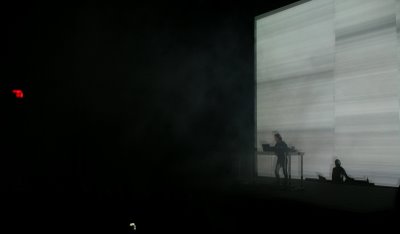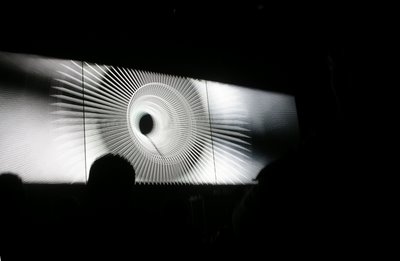To be truthful it is less of a dispatch this time as I am actually back at my desk in Ottawa now. I tried my best to find the time to write notes about the festival while there, but time slips away from you quickly during those things. I do want to share a bit though, because we all now sharing is best . . .
The performance presentations are really the heart of Elektra. I’m not sure of the exact count here, but I think it is somewhere around 8 to 10 distinctly audio-visual works with a few electronic music/DJ + VJ performances bringing in the real dance floor party for the tenth anniversary bash.
The works in this year’s festival seemed heavily influenced by fashions renewed love for the classic contrast of black and white. Otolab, Ryoji Ikeda and AntiVJ never veared, even momentairly, into the subtle ranges of the color spectrum focusing on only contrast as the guiding principal of their presentations.
Amongst those draped in trendy black and white Ryoji Ikeda represented the austere aesthetic best. His presence underneath his massive divided test pattern screen extended his subtle gestures across the 40 foot surface. To mix this perfect execution with the sense of chaotic test pattern derivative was a pleasure to watch. I did here some of the more educated audience members expressing that they where a little dissappointed that this performance did not bring any new ideas, but was rather more of the same. I had never seen one of his performances, so his virtuosity with signal, in visual and audible form, was more than appreciated.
Prior in the same evening as Ikead, Italy’s Otolab presented a somewhat more masturbatory work. What could have easily been a very clean and concise 20-25 minute retro-geometric journey turned into a long drawn out experience leaving you feeling as if you had bee trapped inside an auto-cad program. I understand the hypnotic experience of live audio-visual performance, where you can easily get lost in your own process, but the giant screen and sound is of course not just for you. This being said, of course, I also overhead the younger general audience-types talking of their greater connection with Otolab over the more abstract signal constructions of Ikeda. Perhaps my fear of the Otolab extend-a-mix tainting the experience of the wider audience was unfounded. Consider my tongue bitten . . .
A highlight of the A/V stream of the festival for me was Ryoichi Kurokawa. His 5.1 surround sound tryptich work was incredible. It included subtle and detailed geometric shapes, fascinations so characteristic of videomusic, fading into natural landscapes and then back into their derivative lined representations. The quality of the image was incredible and the structure and timing of the work was equally impressive. It was as if someone had shoved Ansel Adams photography through a Play-Doh Mop Shop that was only capable of producing magnetic straight lines. That probably doesn’t help you picture it. Maybe just go to his website, and I will try and work on bringing him to Ottawa for Electric Fields.
Seeing so much A/V work in a short space got me thinking of one element of this work in particular, for better or worse, the visual elements of the performances frequently functioned as the definition of the experience. While the sound elements of most performances focused on heavy abstract low frequency sounds, the visual elements grounded themselves in tangible forms (or at least explored the relationship between high-definition image capture and its abstraction). Ikeda is an obvious exception here, but to me this highlights the lack of sonic conceptualization in some of the other presentations.
Although AntiVJ also followed the Karl Lagerfeld trend in b&w, but I thought I would give them a special paragraph for the 3D VJ experiment they undertook. Being one of the most anticipated in the Elektra line up puts alot of pressure on you. Having a complicated stereoscopic presentation that was plagued with tech dificulties on it’s first showing in Paris also adds to this. So on these two factors alone I offer a solid nod to the successful execution of the stereoscopic performance. More than that though I think many elements where simple and beautiful. Although, for instance the stars is a terribly obvious place to start it really did feel like they opened a window to the sky when it first began. What was also interesting here is that it felt so solitary. While the other works in the A/V series are heavy on largess this screen was reduced to a more manageable size for the eyes, but the effect of the wearing of glasses made you sink into the 3D space in the screen . . . at least for a while. The lack of visual diversity over the course of Principles of Geometry’s set did send my eyes drifting backwards to look at the sea of standing, swaying, glasses clad digital arts fans. Of course, that turned out to be a treat to because it was really quite an adorable site.
AD
Tags: AntiVJ, Elektra, Festival, Field Trip, Otolab, Ryoichi Kurokawa, Ryoji Ikeda, Stereoscopy

